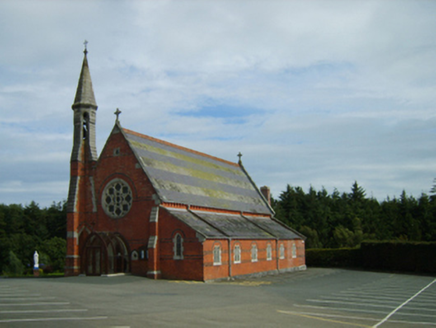Survey Data
Reg No
15611023
Rating
Regional
Categories of Special Interest
Architectural, Artistic, Historical, Social, Technical
Previous Name
Saint Mary's Catholic Church
Original Use
Church/chapel
In Use As
Church/chapel
Date
1880 - 1885
Coordinates
319485, 155847
Date Recorded
08/01/2007
Date Updated
--/--/--
Description
Detached six-bay double-height Catholic church, built 1881-2; dedicated 1882, on a rectangular plan; six-bay single-storey lean-to side aisle (west). Renovated, 1968-9, with sanctuary reordered. "Restored", 1980-1. Pitched banded slate roof; lean-to banded slate roof (side aisle), perforated crested terracotta ridge tiles, cut-granite coping to gables on cut-granite beaded "Cavetto" kneelers with Cross finials to apexes, and cast-iron rainwater goods on "Bowtell"-detailed red brick consoles retaining cast-iron hoppers and square profile downpipes. Red brick Flemish bond walls on rendered chamfered plinth with red brick Flemish bond stepped buttresses including red brick Flemish bond stepped buttresses to corners having cut-granite "slated" coping. Cusped lancet window openings (east) with cut-granite block-and-start surrounds having chamfered reveals framing storm glazing over fixed-pane fittings having leaded stained glass panels. Lancet window openings in bipartite arrangement (side aisle) with cut-granite block-and-start surrounds having chamfered reveals framing "Fleur-de-Lys"-detailed wrought iron bars over fixed-pane fittings having stained glass margins centred on lattice glazing bars. Lancet "Trinity Window" (south) with cut-granite block-and-start surrounds having chamfered reveals framing storm glazing over fixed-pane fittings having leaded stained glass panels. Pointed-arch door opening to entrance (north) front, cut-granite block-and-start surround having engaged Composite colonette-detailed reveals with hood moulding on monolithic label stops framing timber boarded double doors. Quatrefoil-detailed "Rose Window" (gable) with cut-granite surround having chamfered reveals framing fixed-pane fittings having stained glass margins centred on lattice glazing bars. Full-height interior open into roof with carpeted central aisle between trefoil-detailed timber pews, replacement stations (1967) between stained glass memorial windows (1949; 1980) with pointed-arch opposing arcade on Composite pillars, carpeted stepped dais to sanctuary (south) reordered, 1968-9, with replacement Gothic-style reredos (1980) below stained glass "Trinity Window" (1943), and exposed scissor truss timber roof construction on cut-granite beaded "Cavetto" corbels with wind braced rafters to ceiling on carved timber cornice. Set in relandscaped grounds on a slightly elevated site.
Appraisal
A church erected to designs by James Joseph McCarthy (1817-82) and Charles James McCarthy (c.1857-1947) of Dublin (Irish Builder 15th September 1882, 275) representing an important component of the later nineteenth-century ecclesiastical heritage of north County Wexford with the architectural value of the composition, one drawing comparisons with the earlier Catholic Church of Saint John the Baptist (----) in Lispole, County Kerry (Craig and Garner 1975, 29), confirmed by such attributes as the rectilinear plan form, aligned along a liturgically-incorrect axis; the construction in a vibrant red brick supplied by the Courtown Brick and Tile Works offset by silver-grey granite dressings not only demonstrating good quality workmanship, but also producing an eye-catching Ruskinian Gothic palette; the slender profile of the openings underpinning a "medieval" Gothic theme with the chancel defined by an elegant "Trinity Window"; and the "flèche"-like buttressed spirelet embellishing the banded roof as a picturesque eye-catcher in the landscape. Having been well maintained, the elementary form and massing survive intact together with quantities of the original fabric, both to the exterior and to the interior reordered (1968-9) in accordance with the liturgical reforms sanctioned by the Second Ecumenical Council of the Vatican (1962-5) where stained glass signed by Irish Stained Glass (----) and George William Walsh (b. 1939) of Dublin; and a jewel-like "Trinity Window" variously attributed to Earley Studios Limited (closed 1975) of Dublin (Williams 1994, 377) or the Harry Clarke Stained Glass Studios (closed 1973) of Dublin (de Vál 2004, 123), all highlight the artistic potential of the composition: meanwhile, an exposed timber roof construction pinpoints the engineering or technical dexterity of a church making a pleasing visual statement in a coastal village street scene presently (2007) undergoing extensive "suburban" development.

